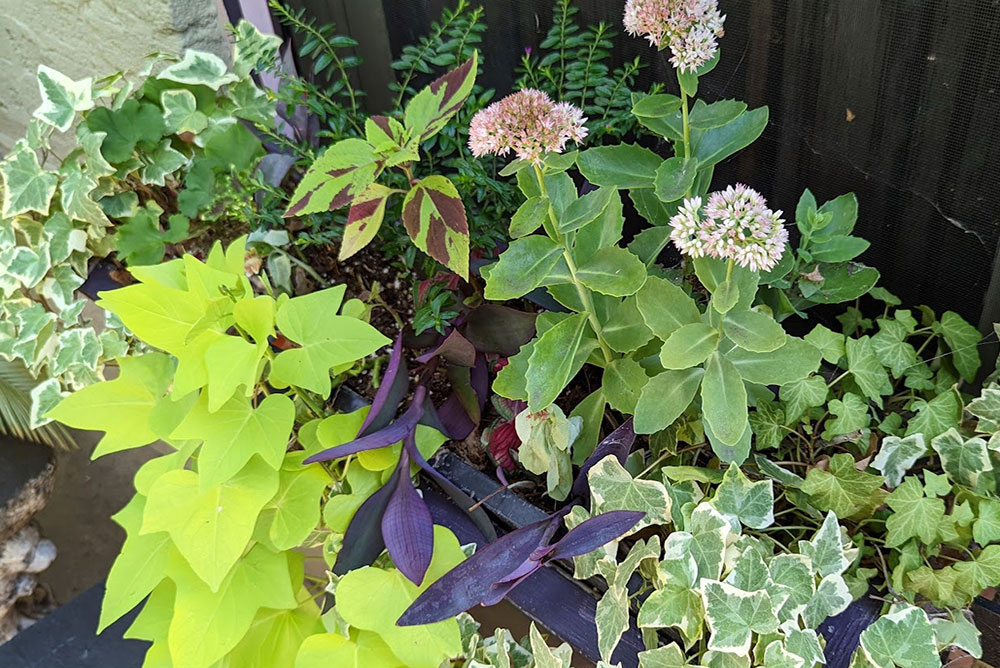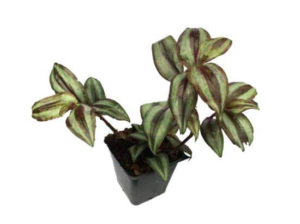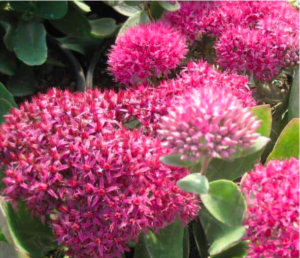
One of my window boxes, with sedum, wandering jew, ivy, sweet potato vine, geranium and a fledgling coleus. / Photo by Stephanie Cavanaugh.
By Stephanie Cavanaugh
LAST WEEK I wrote about the Rose of Sharon, a plant heroic in its ability to withstand anything I can throw at it.
There are plants that others consider foolproof; zinnias come immediately to mind. The sort of plant that clearly states on the seed packets that it’s great for a child’s first garden. No disappointment here, no siree.
I cannot, for the life of me, grow zinnias. The best I did was the year I got one plant and it was orange-flowered. I do not like orange flowers.
All that said, I have a short list of plants that do well for me. That I can abuse, ignore, divide and divide again, and plant with no more sophisticated a tool than a chopstick.
Here are five . . .
 Wandering jew—I know I’ve discussed this little wonder time and again, but it bears repeating. Break off a bit of stem and jab a chopstick into whatever kind of soil, stick the cutting in and boom. This is my original chopstick plant; though a pencil would work just as well, a chopstick lends the process some gravitas. Tradescantia, which comes in various shades of green and purple, sometimes shot with pink or white, is great for plugging garden gaps, planting in containers, and dripping from hanging baskets. They are tropical so will die with first frost; but clip a bit before then, stick it in with some house plants—or even some water in the kitchen window—and you have a starter for the next growing year. You don’t need much: It springs forth from pieces.
Wandering jew—I know I’ve discussed this little wonder time and again, but it bears repeating. Break off a bit of stem and jab a chopstick into whatever kind of soil, stick the cutting in and boom. This is my original chopstick plant; though a pencil would work just as well, a chopstick lends the process some gravitas. Tradescantia, which comes in various shades of green and purple, sometimes shot with pink or white, is great for plugging garden gaps, planting in containers, and dripping from hanging baskets. They are tropical so will die with first frost; but clip a bit before then, stick it in with some house plants—or even some water in the kitchen window—and you have a starter for the next growing year. You don’t need much: It springs forth from pieces.
 Sedum—AKA mid-summer-men, garden stonecrop, livelong, orpine, and (most delightfully) witch’s moneybags, is formally known as Hylotelephium telephium, which rolls off the tongue in a rather bewitching fashion, dontcha think? These are marvelously robust wenches. I had a patch that I actually bought (I think) and planted next to the pond. Though I do nothing to sustain them, they come back each year. Just now, in fact, popped up a densely packed ruffle of pink flower on a six-inch stalk. Thinking to cover a spot of death in the window box one year, I broke off a few stems, took my trusty chopstick, inserted it into said sad spots, and inserted the clippings. Damned if they didn’t take off. And again, with absolutely no more input than an occasional bit of praise, they return each year and last until well past first frost.
Sedum—AKA mid-summer-men, garden stonecrop, livelong, orpine, and (most delightfully) witch’s moneybags, is formally known as Hylotelephium telephium, which rolls off the tongue in a rather bewitching fashion, dontcha think? These are marvelously robust wenches. I had a patch that I actually bought (I think) and planted next to the pond. Though I do nothing to sustain them, they come back each year. Just now, in fact, popped up a densely packed ruffle of pink flower on a six-inch stalk. Thinking to cover a spot of death in the window box one year, I broke off a few stems, took my trusty chopstick, inserted it into said sad spots, and inserted the clippings. Damned if they didn’t take off. And again, with absolutely no more input than an occasional bit of praise, they return each year and last until well past first frost.
 Ferns—Some are a bit tender, like Boston ferns, which won’t survive long in subfreezing weather. But most ferns, such as Autumn Fern, shown, don’t mind frost, dying back but returning year after year. In a shady spot, there’s nothing cooler-looking, or easier. I’ve bought several from Plant Delights Nursery in Raleigh, cadged others from friends or growing along roadsides. I’m just as happy with the latter (truth to tell, I don’t remember which patches are which anymore). They’ll fill up a blank spot fast, providing lush texture, often fanciful forms, and are problem-free. The more common varieties are particularly helpful in an area, say, that’s always behind a chair and is not worth the dollars or effort of a fancier plant. Plus, they’re great at punctuating the whatnots in a flower arrangement, or on their own, swaying about in a vase—instant centerpiece drama.
Ferns—Some are a bit tender, like Boston ferns, which won’t survive long in subfreezing weather. But most ferns, such as Autumn Fern, shown, don’t mind frost, dying back but returning year after year. In a shady spot, there’s nothing cooler-looking, or easier. I’ve bought several from Plant Delights Nursery in Raleigh, cadged others from friends or growing along roadsides. I’m just as happy with the latter (truth to tell, I don’t remember which patches are which anymore). They’ll fill up a blank spot fast, providing lush texture, often fanciful forms, and are problem-free. The more common varieties are particularly helpful in an area, say, that’s always behind a chair and is not worth the dollars or effort of a fancier plant. Plus, they’re great at punctuating the whatnots in a flower arrangement, or on their own, swaying about in a vase—instant centerpiece drama.
 Geranium—This is one I spent years fussing with, reading the wisdom of others to pull them out in November or thereabouts, since they can’t stand severe cold, hang them upside down in the garage or the cellar, then cut back their straggly bits and replant in the spring. Then, one day, I pinched a stem to jam into a sorry-looking pot of something, just for a party, you know. And it rooted. You can have all the geraniums you like with virtually no work and for virtually nothing. I mooched some lovely salmon-colored numbers from a friend last week and stuck them under some potted palms. If you have a sunny windowsill, they’ll do fine in the house over the winter. Propagate by pinching and sticking as spring approaches: You’ll have a planter full. the geranium shown is a Cranesbill (Geranium Maculatum).
Geranium—This is one I spent years fussing with, reading the wisdom of others to pull them out in November or thereabouts, since they can’t stand severe cold, hang them upside down in the garage or the cellar, then cut back their straggly bits and replant in the spring. Then, one day, I pinched a stem to jam into a sorry-looking pot of something, just for a party, you know. And it rooted. You can have all the geraniums you like with virtually no work and for virtually nothing. I mooched some lovely salmon-colored numbers from a friend last week and stuck them under some potted palms. If you have a sunny windowsill, they’ll do fine in the house over the winter. Propagate by pinching and sticking as spring approaches: You’ll have a planter full. the geranium shown is a Cranesbill (Geranium Maculatum).
 Coleus—Showy, showy and utterly foolproof. They come in all manner of psychedelic hues and toss off big leaves with ruffled edges. Their fat stems take to water like thirsty puppies, so you can root them that way. Or, employing the chopstick method, just plant a stem. A little growth hormone doesn’t hurt, though I think this is a knock-on-wood move since they’ll probably root with no effort anyway. Great in the border, boxes, anywhere you need color and fullness.
Coleus—Showy, showy and utterly foolproof. They come in all manner of psychedelic hues and toss off big leaves with ruffled edges. Their fat stems take to water like thirsty puppies, so you can root them that way. Or, employing the chopstick method, just plant a stem. A little growth hormone doesn’t hurt, though I think this is a knock-on-wood move since they’ll probably root with no effort anyway. Great in the border, boxes, anywhere you need color and fullness.
Have a favorite stupidly simple plant you propagate? Let me know!
